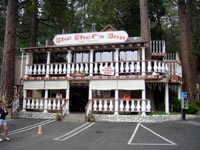|
We celebrated the weekend following the Fourth of July at Lake Arrowhead, high up in the
San Bernardino Mountains. It was cloudy and dark when we arrived, but cleared the following day.
Lake Arrowhead is probably a nice enough place for local residents, but
doesn't offer much for visitors. The lake is entirely private. The only
spot where the public can approach the shore is a shopping mall.
National Forest surrounds the lake and includes hiking trails.
|
|

|
|





|
|
|
We enjoyed a meal at the Chef's Inn and Tavern in the nearby town of Cedar Glen. The building was built in the late 1800s and
doesn't appear to have changed much since. Most of the guests were locals.
Many of the patrons drinking in the ground floor tavern ignored the two musicians playing keyboard and saxophone
-- "hell, we hear 'em every night" --- but enough people got up and danced to make the evening festive.
|
|


|
|







|
We drove further up into the mountains to see Big Bear Lake. Big Bear was beautiful and uncrowded.
|
|


|
|
On the way back from Big Bear, we were delighted to discover the Heaps Peak Arboretum, an easy walk through a 60-acre preserve established
and maintained by volunteers, now officially adopted by the Forest Service.
|
|
|
The Arboretum's handy, clearly-written pamphlet...
|
|




|
|
...described local plants...
|
|
|
This storybook view of the rare Giant Sequoia allows us to look closely at these
majestic trees, able to live up to 3200 years! Sequoia trees represent the largest
tree by volume in the world.
These trees were planted in 1930. Observe the
feathery appearance of Sequoia's foliage, much different from the flattened spray
of the Incense Cedar. Without any fire of animal disturbance, these Sequoia cones
may remain unopened on the tree for 20 years.
These trees have played a significant
role for all in the movement of conservation and the understanding of forest ecology.
|

Sequoia
|
|
|

Manzanita
|
Perhaps the most distinctive shrub in the mountains is the Manzanita, with its twisted branches
and peeling red bark. Thick leathery leaves and pink or white clusters of urn-shaped flowers blooming
in late winter and early spring are also characteristic.
In Spanish, manzanita means little apple,
alluding to the small reddish berries, which are an important food for forest animals. Manzanita berries
were also eaten raw or ground and cooked by Native Americans.
|
|
|
|
|
|
|
|
Early morning and evening provide wonderful opportunities to view the wild
animals visiting this spring. Bear, deer, bobcat, coyote, fox, squirrel,
birds and a host of other animals rely on this spring for water.
Sit down and enjoy the sights and sounds around you. A spring is a very unique
habitat, so it is extremely important that we do not disturb it.
|

Horseshoe Spring |
|
|

Stooping Tree
|
Can you tell the story of 'stooping tree'? Was it a giant who
used this tree as a resting place...perhaps an older neighboring tree
lost its balance, falling onto stooping tree...most likely, snow load
caused this tree to bend into place.
As you walk along, try to look
for clues that tell you a story. Some stumps reveal the natural
occurence of fire in the arboretum. Other stumps are the
result of forest thinning, when foresters create space to give trees more room
to grow.
If you want to know stooping tree's real name, smell to discover what pine it is.
[It was a Jeffrey pine -- the bark smelled of vanilla.]
|
|
|

black bear
|
|

bobcat
|
|
|
The prints of many animals native to the area were stamped into a concrete walkway.
|
|

raven
|
|

raccoon
|
|
|
|

|
|

|
We saw many creatures.
|

|

Steller's Jay
|
|

Nuttall's Woodpecker
|
|

Western Scrub Jay
|
|
|
|
Finally, we watched Fourth of July fireworks from the balcony of the bed-and-breakfast.
The lights on the lake you see in the pictures are hundreds of boats -- a sight as pretty as the fireworks themselves.
|
|






|
|








































